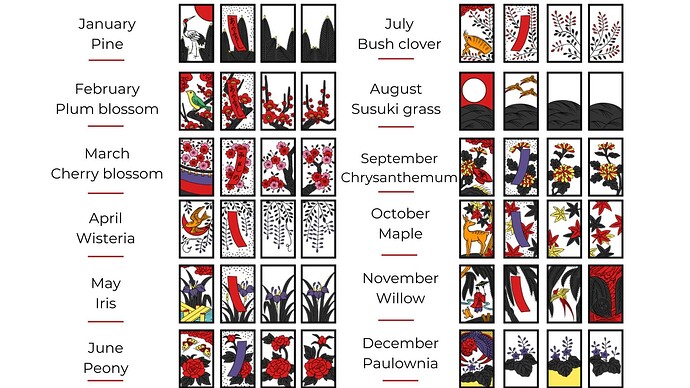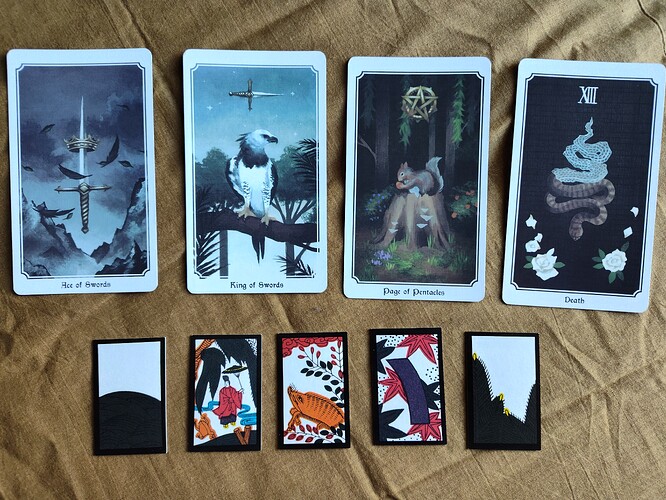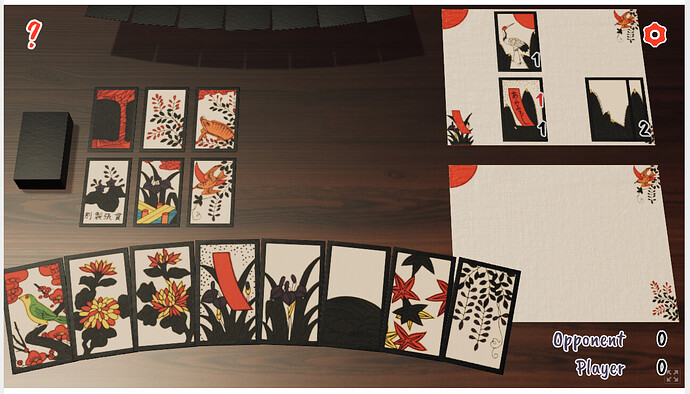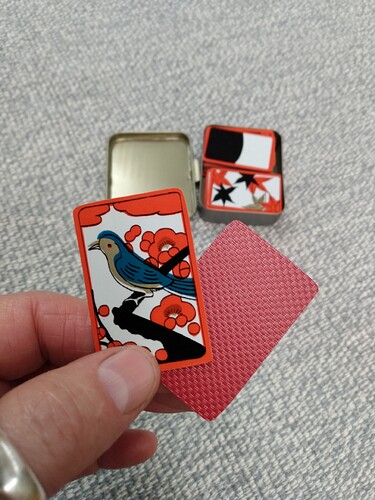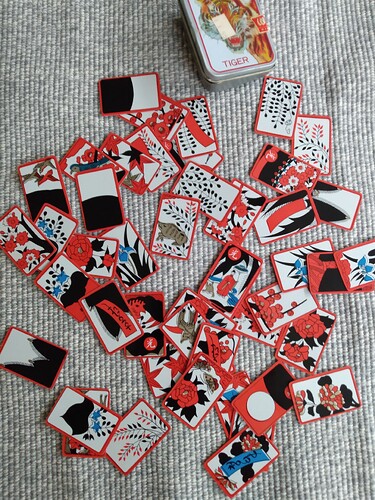Merry meet!
Have you ever heard of flower playing cards? Perhaps you’ve seen them around or caught sight of them in the media.
Even if you’ve never heard of hanafuda, I’m sure you’ve seen the emoji for it! The :flower_playing_cards: emoji is one of my favorite to use for divinatory cards ![]()
![]()
Whether you’re a hanafuda enthusiast or new to the world of flower cards, we’re jumping in to explore a beautiful and nature-based deck of cards with a variety of uses, including gambling and divination. Let’s go!
 What is Hanafuda?
What is Hanafuda?
Hanafuda comes from the kanji 花札 , which can be translated as “Flower” and “Cards”. Modern hanafuda cards tend to be much thicker and sturdier than other playing cards. They are also generally smaller, at about 2.1 inches x 1.3 inches each.
Like tarot and oracle, hanafuda decks can vary dramatically in the art they depict. The most popular modern day decks of hanafuda cards generally feature natural scenes, plants, and animals. There are usually 48 cards (although some decks contain one or more additional blank cards). Hanafuda has 12 suits representing each of the 12 months in a year. Each month is assigned a plant or flower to represent. January is pine, February is plum blossom, March is cherry blossom, etc.
 Cards Across Countries
Cards Across Countries
While hanafuda cards have gone through many transformations (largely to avoid government bans on gambling card games), they are believed to have originated as a local variation of Portuguese-suited playing cards that were introduced to Japan by the Portuguese in the 16th century. Despite the name, Portuguese-suited playing cards don’t seem to have originated in Portugal, but "… were named after the country because Portugal was the last European nation to use them on a large basis."¹ . This means that the cards that inspired hanafuda likely drew from card decks and patterns that were popular in Europe at the time.
Seeing how tarot is largely believed to have developed in Europe in the 15th century (“Tarot decks were invented in Italy in the 1430s”, according to The Britannica), this doesn’t make it a far stretch of the imagination to think that hanafuda may have gained some influence from tarot decks, or perhaps both tarot and hanafuda drew influences from the same earlier decks of cards. Maybe I’m a geek, but it’s neat to see the shared history! In some ways, hanafuda and tarot (as well as other divinatory decks developed in Europe, such as the Lenormand of the later 18th century²) could be considered cousins ![]()
 Hanafuda Card Games
Hanafuda Card Games
Hanafuda cards have been used since their creation to play and gamble - leading to their constant banning by the Japanese government. Luckily, after several centuries of being banned, the Meiji Era of Japan (late 1800s to early 1900s) saw a shift in perception and began to allow playing decks. Hanafuda cards are now used to play several types of card games with variations across Asia. In Japan, they are used to play games such as Koi-Koi and Hachi. In Korea, a similar deck called hwatu is used to play the popular game Go-stop.
Want to try your skills at a hanafuda card game? You can learn how to play Koi-Koi and play online for free at the following websites:
→ Learn & Play Koi-Koi at Board Game Arena (free account required to play)
→ Play Koi-Koi by Otakoda on Itch Games
→ Play Koi-Koi at Let’s Play Koi-Koi App
Fun fact! The company Nintendo was originally founded to produce and sell hanafuda cards. Although their focus eventually switched to video games, Nintendo still produces and sells hanafuda. Read more on the Nintendo website: Revisit Nintendo’s Roots with Hanafuda
 Divination with Hanafuda
Divination with Hanafuda
There are many ways to use and interpret hanafuda cards for divination. The Hanafuda Wiki has a long list of card readers and YouTubers who show various methods of how to use hanafuda for divination.
→ Explore Methods of Hanafuda Divination
In general, there seems to be three main methods for divining with hanafuda.
-
The first method is using your intuition to study the art of the cards. Similiar to intuitive methods of reading tarot or oracle, answers can be deduced by studying the colorful pictures and symbolism of the cards that are drawn.
-
The second method involves a more structured system that uses the seasonal energy of the cards. Because every card has a month and a season, it is easy to associate seasonal themes, temperatures, and energies with the cards that are drawn.
-
The third method involves using a pre-decided system of correspondences where every card or suit of cards in the deck has an established meanings. As shown in the Hanafuda Wiki of divination methods, readers assign meaning to suits, months, and cards. They then refer to these meanings during readings.
From what I can tell, although there are similarities between the methods of hanafuda readers, there is no one widely accepted set of correspondences for the cards. This is likely due to the mysterious history of hanafuda as a method of divination. One blog site claims that although some records indicate hanafuda was used for telling fortunes, actual methods or records may not exist due to hanafuda’s constant banning by the Japanese government at the time.
There is little tradition or coherent system. Perhaps due to the underground nature of Hanafuda, there are few people who claim to be the originators of Hanafuda fortune-telling, so it is doubtful if someone says that he or she is the originator. In a word, it is a mysterious fortune-telling. However, Hanafuda itself was a game “to measure luck”, and it seems to make sense to use Hanafuda to see one’s fortune.
From Nishikei World: How to do Hanafuda Fortune-Telling
This lack of concrete meanings may seem intimidating to some potential readers, but it also leaves the door of opportunity wide open. Hanafuda for divination can be easily adapted to suit your own reading preferences or personal meanings.
I’m not an expert at hanafuda for divination, but the direct association of cards with months and seasons makes me view hanafuda as a good choice for time-based divination readings. A reader may pair a tarot reading with hanafuda where the tarot card speaks to the nature of the situation while the hanafuda card says when that prediction will manifest or occur.
Have you used hanafuda cards before? If not, would you like to give them a try - perhaps for divination or for playing a fun game?
Blessed be! ![]()
![]()
Sources:

